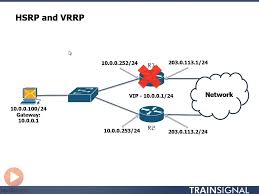A First Hop Redundancy Protocol (FHRP) is a computer networking protocol which is designed to protect the default gateway used on a subnetwork by allowing two or more routers to provide backup for that address; in the event of failure of the/an active router, the backup router will take over the address, usually within a few seconds. In practice, such protocols can also be used to protect other services operating on a single IP address, not just routers.
Examples of such protocols include (in approximate order of creation):
- Hot Standby Router Protocol (HSRP) - Cisco's initial, proprietary standard
- Virtual Router Redundancy Protocol (VRRP) - an open standard protocol
- Common Address Redundancy Protocol (CARP) - free, (patent) unencumbered alternative to Cisco's HSRP
- Extreme Standby Router Protocol (ESRP) - Extreme Networks' proprietary standard with fast failover and also layer 2 protection
- Gateway Load Balancing Protocol (GLBP) - a more recent proprietary standard from Cisco that permits load balancing as well as redundancy
- Routed Split multi-link trunking (R-SMLT) - an Avaya redundancy protocol
- NetScreen Redundancy Protocol (NSRP) - a Juniper Networks proprietary router redundancy protocol providing load balancing

